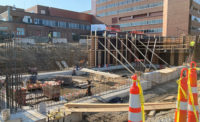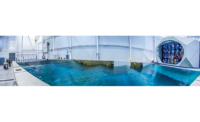“We conducted an analysis of the best shading for summer that would also allow light in for winter,” Krawetz says. Using Ecotect software for exterior shading analysis provided a stereographic chart that gives the position of the sun at different latitudes, depending on the time of year. This assisted with determining proper placement for the fixed solar shading blades.
Syska and Hennessy also created an eQuest energy model for the building. For the 600-ft-long south facade, the software calculated $228,000 in operating savings per year, Krawetz says. “We had many design charrettes with the owner and even considered putting in a wind turbine, but there wasn't enough wind,” Krawetz says. “He wanted practical results.”
Incorporating LEED specifications into the hospital's design made sense both businesswise and for the community, but the owners opted not to go for certification due to the high cost, Rabner says. “We would rather take that money and buy a new MRI,” he says.
The site also includes a cogeneration power plant, developed by NRG Energy, a wholesale power supplier in Princeton. It will generate 100% of the medical center's heating, cooling and power and is expected to reduce energy usage by 35%, Krawetz says. Construction of the cogeneration plant is expected by mid-August. It is expected to be operational by mid-October.
The central utility plant became operational last September and is providing chilled water and steam to the hospital for cooling and heating during construction. In addition, construction of a thermal energy storage tank, which will contain about a million gallons of chilled water for cooling, is scheduled for completion by late October.
Guy Molinari, senior vice president at Voorhees, N.J.-based Concord Engineering, the contractor managing engineering and installation of the system for NRG, says the plant will use a 4.6-MW Solar Mercury 50 gas turbine and heat recovery steam generator (HRSG) that generates electricity and produces 24,000 lb per hour of steam for heating. The HRSG is matched to back-up boilers to provide additional steam during colder winter months.
The efficiency of cogeneration is 65%, compared with only 33% for central energy plants found at most hospitals, Molinari says.
On the design side, HOK relied on evidence-based design, which seeks to improve patient outcomes by creating an environment designed to reduce stress, enhance safety and promote healing.
For example, for more efficient treatment, the hospital now uses a 64-slice CT imaging procedure that requires less space and turnaround time than a heart angiogram, says Chris Korsh, principal at HOK.
Rabner calls himself an actively involved owner who once “viewed the building as a container for people and equipment, but then realized the hospital structure was part of the solution to improving patient outcomes.”
To avoid the spread of infection, for instance, the owner opted for 100 outside air ventilation systems with energy recovery to capture heat from discharged air in the operatory suite, the emergency department and the bed-tower.
Healthcare System officials looked at 1,200 research projects and visited many hospitals with the goal of integrating best practices to help reduce infections, falls and operating costs. “I think we have done things right, but the real answer will come three years after the hospital opens,” Rabner says.
Upon entering the triple-height atrium space at the front of the medical center in Plainsboro, “visitors can easily see any area they need to visit,” Korsh says. Easy navigation is a central goal of the architectural design of the hospital, with the grand concourse creating a circulation spine for the whole building, he says.
“The design was intended to help people find their way easily, minimize distances traveled by patients, visitors and staff, and to help patients feel safe, less stressed and welcome,” says Rabner, who uses his 89-year-old mother as a model to test the suitability of the hospital's design and services. “This sets the bar very high,” he says.











